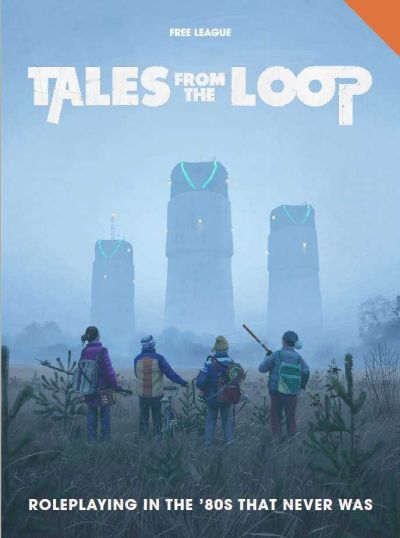Sun Is Cold and Rain Is Hard
Tales from the Loop
By Simon Stålenhag, Nils Hintze & Tomas Härenstam

12 Oct, 2022
Fria Ligan’s 2017 Tales from the Loop is an alternative history tabletop roleplaying game, set in a retro futuristic world beautifully evoked by Simon Stålenhag’s art. Nils Hintze was lead game designer and Tomas Härenstam was editor and project manager1.
Tales from the Loop is a mystery-solving roleplaying game in which Kids aged ten to fifteen are confronted by and solve (or fail to solve, for which there are always consequences) the mysteries that the adults around them are determined to ignore.
The Loop, largest particle accelerator in the world, was intended to advance the cause of human science. Thanks to certain unexpected emergent properties, in the decades since the Loop was activated it has transformed the otherwise backwater Mälaren Islands (Or Boulder City, Nevada if one uses the American setting). By the 1980s, weirdness abounds!
Adults appear determined to ignore the anomalies. Luckily, the player characters are Kids, not yet stunned by adulthood (in this game, mechanically indistinguishable from death) into mute compliance with convention, and bored enough to be intrigued by local mysteries. Happily, Kids cannot die. Less happily, other forms of trauma abound.
Commentary to come
The first thing readers are likely to notice is that the core rules are displayed in a well-made and (thanks to Simon Stålenhag’s abundant illustrations) beautiful 191-page rule book. The paper is non-gloss. While the index is rudimentary at best, each chapter has a detailed table of contents. The internal organization is sensible. However, because the book finishes with sample adventures, players should stop reading the rulebook at chapter seven.
The character generation and game mechanics are straightforward. Although Fria Ligan’s sale department probably does not want me to say this, one copy might well suffice for each Tales from the Loop group. The advice on structuring mysteries is useful and could be repurposed for other mystery-oriented games (of which there are many; I’m sure I don’t need to itemize). The game could easily be used to play a wide variety of youth-oriented mystery/supernatural games.
This is the product of a nation that gave us Kurt Wallander, Martin Beck, and Evert Bäckström2; the tone is melancholy. While the RPG draws on 1980s nostalgia, it acknowledges all the flaws of the period, flaws which the addition of some science fiction elements fails to ameliorate. Kids are often bored or worried, the adults are useless or worse, and all that the Kids can expect from life is grim adulthood. Because they are functionally indestructible, Kids cannot even hope for death. At least they have the distraction of their mysteries!
Tales from the Loop is available here and here.
The details:
01: Welcome to The Loop
This chapter is an introduction to RPGs (what are they and how do they work) and to this game in particular. It outlines the five principles that shape this setting. To quote:
1. Your home town is full of strange and fantastic things.
2. Everyday life is dull and unforgiving.
3. Adults are out of reach and out of touch.
4. The land of the Loop is dangerous, but Kids will not die.
5. The game is played scene by scene.
6. The world is described collaboratively3.
02. The Age of The Loop
A guide to the strangely altered 1980s Sweden in which the game is set. Many details are as they were in our world — Cold War, VCRs, video games, useless adults fumbling their way through a world they resolutely misunderstand — while other details — magnetically levitated vehicles, robots, holes torn through time itself — are different.
03: The US Loop
As in 02 but for Boulder City, Nevada.
04: The Kids
Character generation. Players pick one of eight archetypes (Bookworm, Computer Geek, Hick, Jock, Popular Kid, Rocker, Troublemaker, Weird), then customize them to produce a diverse array of characters, each with their own strengths and challenges.
Older Kids tend to be more capable but younger ones are luckier. As well, characters become unplayable at sixteen.
05: Trouble
This chapter focuses primarily on the game-mechanic aspects of the challenges player characters will face.
Task resolution is generally accomplished by rolling variable numbers of six-sided dice, hoping for at least one six.
06: The Mystery
Tales from the Loop is essentially a mystery-solving game. This requires game masters to know how to structure a mystery-oriented plot. Several alternatives are provided.
07: The Mystery Landscape
This chapter provides an alternative to game-master-created mysteries.
08: The Four Seasons of Mad Science
Capsule backgrounds for four linked mysteries, which together form a short campaign.
Needless to say, players should stop reading the rulebook at chapter seven.
09: Summer Break and Killer Birds
What secret explains the anomalous, alarming behavior of local birds?
10: Grown-Up Attraction
What secret explains the anomalous, alarming behavior of local adults?
11: Creatures from the Cretaceous
What secret explains the disappearance of a local pet?
12: I, Wagner
What secret explains the peculiar behavior of local robots?
1: Additional credits include but are not limited to:
The Year Zero game engine: Tomas Härenstam
Additional writing: Matt Forbeck, Nils Karlé, Björn Hellqvist
Illustrations: Simon Stålenhag
Graphic design & maps: Christian Granath
Prepress: Dan Algstrand
Proofreading: John M. Kahane, Rickard Antroia, Kosta Kostulas, T.R. Knight
Playtesters: Vincent Chang, Geoffrey Norman, Jessica Chang, Kimsan Kim, David Sack, Rickard Antroia, Tove Lindholm, Staffan Fladvad, Sandra Abi-Khalil, Leif Westerholm, Artur Foxander, Fia Tjernberg, Anton Albiin, Leili Mander, Kosta Kostulas, Marco Behrmann
Special Thanks to Rickard Antroia, Björn Hellqvist, Therese Clarhed and Simon J Berger
2: I expected a hat tip to youthful master detective Kalle Blomkvist (Bill Bergson in the US editions), but aside from a character named Kalle, there is no such mention. At least one that a quick search of the pdf turned up.
3: Which is to say, both gamemaster and players shape the events of the game.
